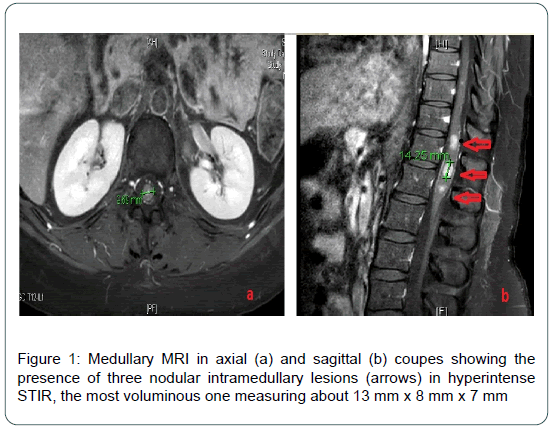Case Report, Clin Oncol Case Rep Vol: 5 Issue: 12
Intra Medullary Metastasis of Breast Cancer
Zakaria Ahmed Youbi*
Department of Radiation Oncology, Ahmad Ben Zayed Al Nahyan Center for cancer Treatments,CHU Tanger-Tetouan-Al houceima, Tangier, Morocco.
*Corresponding Author: Zakaria Ahmed Youbi
Department of Radiation Oncology,Ahmad Ben Zayed Al Nahyan Center for cancer Treatments, CHU Tanger-Tetouan-Al houceima, Tangier, Morocco.
E-mail: zakaria.youbi@gmail.com
Received: November 22, 2022; Manuscript No: COCR-22-81193;
Editor Assigned: November 24, 2022; PreQC Id: COCR-22-81193 (PQ);
Reviewed: December 08, 2022; QC No: COCR-22-81193 (Q);
Revised: December 12, 2022; Manuscript No: COCR-22-81193 (R);
Published: December 19, 2022; DOI: 10.4172/cocr.5(12).264
Citation: Youbi ZA (2022) Intra Medullary Metastasis of Breast Cancer. Clin Oncol Case Rep 5:12
Abstract
Intramedullary metastases constitute a rare evolution of cancers (minus two 1%) including breast cancer. the clinical picture is non-specific ranging from simple vertebral pain to spinal cord compression which is an extreme oncological emergency. their diagnosis is based on MRI magnetic resonance and the treatment involves surgery and/or radiotherapy after multidisciplinary consultation. we report a case of intramedullary metastases of breast cancer treated by radiotherapy with a good clinical and radiological evolution.
Keywords: Breast cancer; Intramedullary metastases; Radiotherapy; Case report
Introduction
Intramedullary Metastasis (MIM) are uncommon outcomes in breast cancer history [1, 2]. They represent 1% of all metastases and 1% to 8% of the Central Nervous System (CNS) metastases [1-3]. Brain metastases and MIM are frequently correlated. The diagnosis is mainly based on medullary Magnetic Resonance Imaging (MRI), showing the local tumor and distinguishing it from differential diagnosis, such as radiation myelitis, necrotizing myelitis or meningeal carcinomatosis [4].
Case Report
We report the case of a 35-year-old female patient, followed in Oncology-Radiotherapy department. Right breast biopsy revealed a grade 3 infiltrating ductal carcinoma. Hormonal receptors and Her-2 expression were found positive. Brain, liver and bones metastasis were detected at the time of diagnosis. She received brain radiotherapy (30 Gy) and then put under palliative oral chemotherapy associated with hormonotherapy with a good clinical outcome. Three months later, she developed neurological symptoms of medullary compression. The clinical examination found an incomplete left pa raplegia wi th left leg anesthesia, right motor deficit (3/5). No sensory or sphincter disturbance were found and no pain symptoms. The MRI showed three nodular intra-medullary lesions localized at the terminal cone. The largest one was located on T12-L1, measuring 13 mm x 8 mm x 7 mm (Figure 1). The other two were located next to T12 and L1. The patient receveided high dose of corticosteroids and decompressive radiotherapy was performed with 30 Gy in 10 fractions of 3 Gy, improving initial symptoms. Another line of chemotherapy was recommended because metastatic disease progression.

Figure 1: Medullary MRI in axial (a) and sagittal (b) coupes showing the presence of three nodular intramedullary lesions (arrows) in hyperintense STIR, the most voluminous one measuring about 13 mm x 8 mm x 7 mm
Discussion
Intramedullary metastases constitute a serious course of the cancerous disease [1-3]. It is rare and represents less than 1% to 2% of metastatic sites [4]. the localization at the cervical spinal cord is the most frequent [1-5]. lung cancer is the pritmitif most often involved, followed by breast cancer which is frequent in our context, then comes melanoma, renal cancer and more rarely prostate carcinoma [1,3,5,6]. the hematogenous route is the most probable route of dissemination.
The diagnosis is essentially based on medullary MRI which most often s hows n odular lesions i n t he m edullary c anal i n T1 hyposignal-T2 hypersignal and after injection of Gadolinium [6]. The treatment is mainly palliative, requiring high dose corticosteroid therapy and radiotherapy on the affected marrow [7]. the evolution is often marked by a regression or a stability of the lesions but the prognosis remains poor because of the medullary localization and the speed of the evolution of the cancerous disease.
Conclusion
The occurrence of metastasis is a pejorative turning point in the evolution of cancers. The intramedullary localization is exceptional but existing and will have to be considered in the face of any neurological symptomatology. Magnetic resonance is the key exam for definitive diagnosis. Despite medical treatment by corticosteroid with surgery or palliative radiotherapy, the prognostic remains poor.
References
- Costigan DA, Winkelman MD (1985) Intramedullary spinal cord metastasis: A clinicopathological study of 13 cases. J Neurosurg 62: 227-233. [Google Scholar] [Cross Ref]
- Findlay JM, Bernstein M, Vanderlinden RG, Resch L (1987) Microsurgical resection of solitary intramedullary spinal cord metastases. Neurosurg 21: 911-915. [Google Scholar] [Cross Ref]
- Bappon KD, Hirano A, Araki S (1959) Experiences with metastatic neoplasms involving the spinal cord. Neurology 9: 91. [Google Scholar] [Cross Ref]
- Schiff D, O’Neill BP (1996) Intramedullary spinal cord metastases: Clinical features and treatment outcome. Neurology 47: 906-912. [Google Scholar] [Cross Ref]
- Amin R (1999) Intramedullary spinal metastasis from carcinoma of the cervix. Br J Radiol 72: 89-91. [Google Scholar] [Cross Ref]
- Jardin F, Stamatoullas A, Fruchart C, D’Anjou J, Glement JF, et al. (1999) Intramedullary spinal cord metastasis and leptomeningeal involvement in Hodgkin’s disease: Case report and review of the literature. Rev Med Intern 20: 267-271. [Google Scholar] [Cross Ref]
- Li Y, Takayasu M, Takagi T, Yooshimoto M, Mitsui Y, et al. (2000) Intramedullary spinal cord metastasis associated with hemorrhage: A case report. J Neuro Onco 28: 453-457. [Google Scholar] [Cross Ref]
 Spanish
Spanish  Chinese
Chinese  Russian
Russian  German
German  French
French  Japanese
Japanese  Portuguese
Portuguese  Hindi
Hindi 